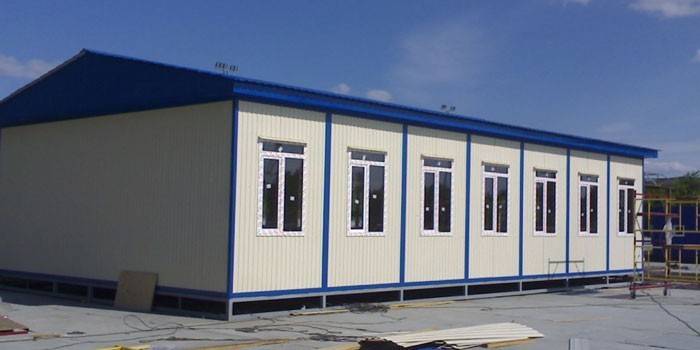Skip to content
iQ Review Independent journalism
.
04/13/2018 at 17:54 15 min. 11880
Shift work - what is it? How does it differ from other types of activity, what features and nuances does it involve?
The rotation method is one of the options for work that is not performed at the person’s place of residence. In this case, the employee’s daily return home is impossible. Nowadays, this kind of work option occurs when we are talking about seasonal employment, work in timber and oil extraction. People also work in this way in fishing, while searching for deposits of precious metals and stones. Seasonal shift work is also different, most often relevant in the summer.
- Shift work - what features need to be understood?
- Working as a shift worker in the north - what are the conditions and nuances?
- Remuneration: why is working as a watchman profitable?
- What payment options are there?
- What should you know before your trip?
- Shift work. Detailed video
What is a shift work method?
Traditionally, the rotation method is a shift activity, seasonal, temporary or permanent. There is no need to confuse shift work and shift work. Shift workers cannot go home after the end of the working day and remain to live for some time in the production itself, while shift work is when they have completed working hours and gone home.
More frequent vacancies are in the Far North and its sparsely populated areas, where there is production. If you search on the Internet, you can find many rotational vacancies, both for specialized qualified specialists and for simple general workers, cooks, and security guards. The main direction is production and industry:
- Logging.
- Mining of oil and gas.
- Exploration and production of minerals, precious metals, coal deposits, etc.
- Railway transport.
- Fish farming and others.
What is the reason for the popularity of the method? The main function is the need and order of the employer for a large number of employees. Although such work is paid more expensively and requires more expenses, the industry employer is ready to provide workers with all the necessary conditions and provide all payments. After all, the main criterion is the result - a well-established production process without failures or interruptions (for example, when producing petroleum products, it is important to comply with all technical and time deadlines).
Where is this type of employment most common? In first place are hard-to-reach and sparsely populated areas in Russia - for example, in the Far North. Reconstruction and construction of large objects of industrial or cultural significance, their further support and maintenance, is carried out by rotation workers. Extensive experience is not required. Attracting foreign citizens for employment in factories, manufacturing factories, and in the service sector is also work on a rotational basis.
Schedule
Shift work for men and women involves following a schedule. It must be specified in the contract. The employer is obliged to coordinate it with the opinions of people. The main document in which the schedule is prescribed is the Regulations on the Shift Work Method. It is a local legal act.
According to the Labor Code of the Russian Federation, the total duration of working time during the period of stay on shift cannot be higher than the number of hours approved by the Code. One shift can be a maximum of 12 hours. The number of days off should not be less than the number of weeks in a month.
Rest days may be provided unevenly, the main thing is that their number complies with the norms. The work schedule is determined by the number of employees, as well as individually. The second option is used, for example, when a person finishes work and plans to leave, transferring responsibilities to a deputy.
Peculiarities of organizing a shift in Moscow and St. Petersburg
Not only in the North, but also in large cities there is a great need for labor. But large companies are more loyal to employees and do not always look at the experience, length of service of employees, education and existing skills. Large cities such as St. Petersburg and Moscow are constantly expanding, which naturally increases the need for construction companies.
The vacancies offered in the labor markets in the capitals are associated not only with construction, but also with the increase and improvement of infrastructure; foremen, drivers, loaders, security guards, workers in super and hypermarkets are always needed. Not every woman will be able to find such employment for herself, but there are vacancies for them too - warehouse manager, nanny, nurse, au pair, cashier in a store and everything related to the service sector. There is a lot of competition in all these fields, which increases the number of vacancies.
This organization of work is beneficial to the employer, because it significantly increases productivity. In this case, the hiring party must provide employees with all living conditions and ensure reception. These are either specially created residential towns or places in dormitories. And, before going to work on a shift, it is worth clarifying the issue of living conditions with the employer.

Laws
Actually, about legal regulation. As we said above, the main source that normalizes the shift work method is the Labor Code. It contains sections that contain special wording adapted to this employment format. Let's study them. There is an opinion that the rotational method of work in Russia has largely become popular not only because of high salaries, but also due to the provisions of labor legislation that are loyal to hired employees. Is it really? Shift work method - what is it from the point of view of specialized sources of law?
The norms in question are mainly set out in Article 47 of the Labor Code of the Russian Federation. First of all, it sets out general provisions regarding the regulation of work on a rotational basis. In particular, a definition of this format of work is given. According to the legislator, the rotation method is a specific type of implementation of the labor process, provided that the place of work does not coincide with the city of residence of the employees, and, moreover, their return there on a daily basis cannot be ensured. This method of employment is used by companies, if you follow the wording of the Labor Code, in order to optimize the timing of necessary work, such as construction, reconstruction or repairs in areas characterized by special natural conditions. It is also possible that a rotational work method is a way to reduce the corresponding costs when an enterprise carries out production activities.
Legal regulation
Before applying for a job in a company on a rotational basis, it would be a good idea to familiarize yourself with the Labor Code of the Russian Federation; such activities are regulated by a specific article of the Law. According to Article 297 of the Labor Code of the Russian Federation, a shift is a type of legal labor activity when the daily return of a worker to his place of registration is impossible. This type of employment is not a business trip; all working time spent at production (shift) and rest between shifts are considered a shift. Registration is carried out according to the employment contract.
Working hours should not exceed one month in duration, although the employer can increase the period of service to three months, having previously justified its decision with an order indicating the reasons for the increase in shifts and facilities. The length of the working day by law should not exceed 12 hours. Anything in excess can be considered processing and is paid additionally (Part 1 of Article 299 of the Labor Code of the Russian Federation). The schedule is established by the employer.
On shift, labor time is constant, without days off, the working day is 12 hours, then taking these hours into account, overtime occurs and unused weekends remain, of which there must be at least 4 per month. These overtime hours are compensated by payment at the daily rate, or days off. Time off or vacation, in this case, is carried out outside the rotational facility at the place of residence (Part 3 of Article 301 of the Labor Code of the Russian Federation).
Often the shift is located at a considerable distance from the employee’s place of residence and you need to somehow get to the point. From the collection point, which is designated by the hiring company, to the office, the cost of travel is paid by the employer, while the days spent on travel are considered working days and are paid at the daily rate (Part 8 of Article 302 of the Labor Code of the Russian Federation). But the employee will have to get to the collection point on his own; according to the law, the employer does not pay for this period of travel, unless otherwise provided by internal orders and agreements of the shift site.
What is a shift according to the Labor Code of the Russian Federation
The rotation method is a special form of carrying out the labor process “away from home”, the basis of which is the impossibility of ensuring the daily return of workers to their place of permanent residence (Part 1 of Article 297 of the Labor Code of the Russian Federation). It is understood that the employer guarantees the provision of all living conditions, ensures vital functions, and organizes delivery from the collection point to the destination.
Order of the enterprise on the organization of rotational work
Before making a decision to introduce a rotational method of labor organization, the enterprise carries out a technical, economic, economic calculation, on the basis of which the feasibility and effectiveness of the transition to a new type of work activity is determined. The administration or manager issues an order that the enterprise transfers or introduces rotational work. Approval of the order includes:
- the fact of change, transfer and their implementation at the enterprise;
- summarized time tracking;
- for what period is the summarized working time taken into account;
- terms of remuneration, specifically:
- private enterprises set their own level of premium for shifts; in government agencies this allowance is regulated by law;
- district coefficient;
- allowance and bonus percentage “northern”;
- duration of the shift, number of days of work and days of rest;
- sometimes a list of employees who are prohibited from being involved in this type of activity is displayed;
- a note on the minutes of the trade union meeting (why is a trade union protocol needed in this case? A trade union is a means of regulating and agreeing on all the terms of an agreement with employees so that all procedural and legislative acts are observed);
- It is obligatory to note that employees are familiar with the contents of the order.

The difference between a shift and a business trip
There is a misconception that a shift is a type of business trip. This is wrong. The fact is that a person who is sent on a business trip by his employer is carrying out an official assignment.

In this case, payment occurs, as a rule, within the framework of the current salary and allowances. In turn, the rotational method of organizing work implies that a person travels to a remote site in order to perform not an assignment, but a separate function of a labor nature. In the second case, a separate contract is often concluded, which fixes the salary and other working conditions. When traveling on business, as a rule, changes are not made to an already signed employment contract.
Types of watches
There are different types of watches - intraregional and expeditionary, or between regions. If the intraregional type assumes a not too long period of activity - 2 weeks and the facility itself is not too far from the employee’s place of residence, then the second type is longer. The expeditionary or interregional option not only lasts longer than a regular shift, but the facility is also located further away. A research expedition can also be considered a rotational work method.
What is the difference between a shift and a business trip?
This should not be confused with a business trip. There is some difference:
- A business trip is a trip to carry out some assignment from management. The shift is a full 12 hour shift.
- Payment. On a business trip, a standard working day, plus some allowances. During employment, a separate legal contract is concluded, which stipulates the terms of remuneration, composition, volume of labor and period of employment.
- A medical examination is not required when traveling on a business trip, whereas for long-term shift work, a medical record is required (contraindications must be noted).
- On a business trip there are no restrictions on the length of stay, neither minimum nor maximum. On shift, the duration of service is no more than one month (in some cases up to three months).
Features of work organization
A shift involves performing work without returning home to your permanent place of residence for some time. Breaks serve as rest. Usually the shift lasts 2 weeks, and the same amount of time is provided for the trip home. By law, working hours cannot exceed 30 days.
If this is agreed upon with the trade union committee, then the duration of work is allowed up to 60 days. Shift workers are usually accommodated in special housing, where there is everything necessary for people to live. Rotational camps must have heat, water, electricity, mobile communications, medical care, and cultural facilities. The area where the activity is performed is the place of work. Often a change in its location is required.
The following cannot work on a rotational basis:
- Minors.
- Pregnant women.
- Women with 3 children.
- Without medical permission.
Shift work, although considered lucrative, is still quite difficult. People are screened before being hired. The list of doctors depends on the specialty. If you don’t have medical clearance, you won’t be able to get a job.
Labor organization conditions when working on a rotational basis
Such employment is beneficial for both the employee and the employer. But, it should be understood that this type of activity is not only a distance from home and living on the employer’s territory, but also hard, many-day physical work in harsh climatic conditions, which not every person can do. It is very important to understand that only a healthy person in good physical shape can work without compromising his health.
Who can work
The most important criteria for selecting applicants are physics and human health. To get a job in this field, you need to undergo a medical examination, which will help not only to identify diseases that impede hiring, but also to prevent the risk of their occurrence. Permission from a general practitioner, cardiologist (the risk of cardiovascular diseases in the Far North is very high), narcologist and psychiatrist is required. Examinations by other doctors are regulated by the enterprise, depending on the type of activity, and are approved by internal orders and local acts.
Hiring restrictions
A certain category of citizens cannot get a shift:
- minors;
- pregnant women;
- guardians of three or more children;
- persons who have not passed a medical examination or have not been admitted based on the results of a medical examination confirming their incapacity for work. Such citizens may be prohibited from serving on shifts or restrictions may be imposed.
Organization of work and rest schedule
Calculation of working hours differs from calculation of regular service. The accounting displays the entire working period, including time spent on travel and rest between shifts. The working day should not exceed 12 hours, including a lunch break. You cannot go to work two shifts in a row. The number of rest days must be at least 4 and fall on any day of the week.
The shift schedule and its assignment are established by the employer. The optimal schedule is 2 weeks of work, 2 weeks of rest. But, at some facilities the shift period can be 30 or 60 days. Rest between shifts is called inter-shift, and is carried out by the employee outside the service facility. It is understood that at the place of residence. This type of vacation is periodic and is provided several times throughout the year. In this case, vacation is paid at the standard rate, without extra charges for the harsh climatic region and working conditions.

Full cycle of shift work
In general, you can display the time taken into account when calculating for a shift from and to in the list:
- time spent traveling from the collection point (set by the employer) to the final destination;
- time spent on the direct performance of the employee’s direct duties;
- and in reverse order - days spent traveling from the place of work to the collection point;
- the time period allotted for inter-shift rest.
Shift schedule
To optimize and normalize working hours at an enterprise operating on a rotational basis, a special schedule is created. It displays the entire cycle of activity. All shifts are indicated for each employee, indicating how many hours this or that hired employee worked by name. The document displays the time spent transporting workers from the collection point to the shift and back and the period of rest between shifts. The immediate supervisor is responsible for maintaining the schedule.
Shift duration
As already mentioned, the duration of a daily shift should not exceed 12 hours, while time for breaks and lunch is provided during work. Sometimes the shift increases to 14 hours a day, but no more than double. And the total time of employment at each enterprise is set individually. This is a multi-time continuous schedule of 10/10 (10 working days for 10 days of vacation), 14/14, 30/30, but not more than 60 days according to the law of the Russian Federation.
Time relax
After the end of the working day, it is time to rest. All the time remaining at the end of the working day can be considered rest and the employee does not leave the area of residence at the facility. The rest period between shifts is set individually at each enterprise; the employee travels outside the territory of residence at the facility; such vacation periods are considered long - from 10 to 60 days.
- How to sterilize jars in the microwave
- How to change tariff on Beeline
- Kidney pressure: symptoms and treatment of the disease
Rotation camps
Considered temporary housing, they are arranged specifically for 1.5-2 years in close proximity to the work site. The construction of such buildings is optimal if it is not profitable for the employer to rent housing, and the work site is located in a sparsely populated or remote place. The development of the town presupposes not only the presence of residential apartments, but also household premises (canteen, first-aid post, bathhouse, store, etc.) and the infrastructure must be developed.
The premises must comply with sanitary standards and must be equipped with the necessary furniture, household appliances, household equipment, bedding, and fire safety equipment. Providing communications - heating, sewerage, water supply, lighting - is a necessary norm. The materials used in the construction of settlements are different - wood, sand blocks, slabs, but recently collapsible container blocks with connected communications have become popular.

Work without building a residential complex
Not every company can afford to build an autonomous rotational camp with all communications and important infrastructure. Often, an organization (especially a construction organization) provides construction trailers for accommodation. Large enterprises provide a dormitory for several people or a separate building. If the enterprise is located near a populated area, the institution can provide rental housing or pay rent.
Salary
The shift method of work differs from the usual one in some changes in remuneration. There are guaranteed allowances for shifts, housing is provided or paid for separately, and travel in both directions is paid based on the daily rate. There are also district (regional) allowances and payments for work in the Far North, and additional paid vacations. Taxation on shift pay is calculated in the same way as other income.
There are several remuneration systems:
- time-based;
- tariff;
- piecework;
- piecework-bonus;
- time-bonus;
- salary system.
Shift workers are paid:
- Piece workers - for the volume of work performed according to current standards and prices.
- For time workers - for all actually worked time in hours based on the established tariff rates of the assigned categories.
- Foremen, foremen, heads of workshops (shifts) and other line (shop) personnel directly involved in management at the facility (site) - for all time actually worked according to the schedule (in hours) based on the established monthly official salaries. The hourly rate of employees in these cases is determined by dividing the monthly official salary by the number of working hours according to the calendar of the billing month.
- For other managers, specialists and employees working on shifts - for the actual time worked (in days) based on the established monthly official salaries.
- Any action or circumstance that entails changes in remuneration is regulated by the legislator.
Summarized working time recording
It is used when, for various objective reasons, the working day or working week is not standardized. In this case, working time is recorded in a schedule indicating the number of hours worked by a specific person. Wages are calculated for a certain period of time - per week, per month, per six months. The basis for calculations is either the hourly rate or the monthly salary of a certain position. Working hours are recorded by month and for the accounting period as a whole.
Allowances and surcharges
The size and procedure for paying the bonus are established by law and are based on the Labor Code (Article 302 of the Labor Code of the Russian Federation), but there are also some nuances. So, premiums are set depending on funding (state, budget, private, and so on):
- The Government of the Russian Federation for employees of organizations financed by the federal budget.
- Bodies of local government and self-government for budgetary subjects of the Russian Federation.
- Collective agreements, local acts and orders of organizations and trade unions for employees of organizations not financed from the budget.
- The amount of the bonus is established by law (Resolution of the Government of the Russian Federation No. 51 of 02/03/2005) for budgetary organizations:
- in the Far North and equivalent regions - 75% of the tariff rate (salary);
- in Siberia and the Far East (and other similar natural and climatic regions) - 30% of the tariff rate (salary).

Compensation for irregular working hours
The law does not indicate that the employer must pay compensation for irregular working hours. Some organizations establish such payments by issuing a local order and consider them as overtime. Most often, for overtime hours worked, hours or days are added to the annual paid leave. This point, how irregular working days are compensated, what compensation is implied, should be discussed with each employer individually in advance.
Allowances for work in difficult working conditions
Employees who work in the Far North or in regions equivalent to it are entitled to a separate allowance. This bonus is not related to the rotational method of work, that is, it is considered separately, regardless of the work schedule of an employee of a particular organization and is a compensation payment. The calculation of this allowance is regulated by the Labor Code of the Russian Federation.
Providing additional vacation days
Employees working on a rotational basis have the right to receive not only 28 days of annual paid leave, which labor legislation provides, but can also count on additional paid leave if the employee works in the Far North (24 calendar days) or in a region equivalent to it (16 calendar days).
Accommodation
It is assumed that the shift method of work involves difficult conditions not only in terms of climate, but also accommodation. Everything, however, depends on the criteria by which to evaluate the comfort of life. As a rule, shift workers have at their disposal, although small in area, fairly well-equipped resources for living. Modern modular designs allow the employing company to quickly build housing with acceptable infrastructure: water supply, electricity, heating. The structure of living quarters for shift workers, as a rule, includes dining rooms, leisure rooms, and the ability to access the Internet. The law requires the employing company to ensure a reduction in the time spent traveling for employees from their place of residence to the facility where work is expected to be performed.

At the same time, the rotational housing complex is inspected by a special commission before it is put into practical operation. Its members include representatives of the employing company, officials of the municipality in whose territory the shift will operate, in some cases, trade union employees, and specialists from various government services. Upon inspection, a certificate of acceptance of the complex into operation is supplied. The rotational camp is intended to accommodate not only hired employees who will perform targeted labor functions, but also personnel. At the same time, as soon as the work season ends (the objects are erected), everyone must leave the housing complex. An option is possible in which work on a rotational basis with accommodation is organized without the construction of a separate complex. In this case, the hiring company places people in hotels or corporate apartments.
Payment for inter-shift rest
Due to the fact that each day of the shift can be considered irregular, objective inter-shift leave is calculated differently, for each calendar day, and is compensated by days and hours worked. Calculation algorithm:
- Calculation of the normal number of working hours for the accounting period.
- Calculation of the number of working hours according to the schedule.
- Determination of the number of hours and the standard for processing or underworking in relation to the standards established by law.
- Establishing the number of hours and whole days that relate to days of inter-shift rest.
- The resulting overtime in whole days is paid at the tariff rate or salary, and the hours are summed up and can be accumulated and transferred to another type of vacation as soon as a sufficient number of hours are accumulated to receive additional days added to the vacation.
Rest
The main legislative document regulating the shift method of work, the Labor Code, contains the term “rest between shifts.” Its meaning is defined as follows. These are days of rest (sometimes called compensatory days), which appeared as a result of hourly overtime of the working hours established by the work schedule at the rotational site. Some lawyers consider inter-shift rest to be a kind of analogue of vacation, but provided not on an annual basis, but due to the objective capabilities of the employer. But the frequency of such time off can reach several times a year. Also, inter-shift vacation differs from typical vacation in the way compensation is calculated. Its base is not average earnings. The number of days of inter-shift rest is also calculated differently. To do this, the sum of all overtime hours is divided by 8 (based on the standard working day according to the Labor Code). At the same time, an option is possible in which inter-shift rest will be paid in the amount of salary. In practice, this is possible if the corresponding time off is provided by the employing company in the form of compensation for extra hours within the accounting period.

Regarding the relationship between vacation and inter-shift rest, some lawyers recommend paying attention to the following feature. The fact is that, as a matter of priority, time off for overtime must be provided. And only after a person uses them, he can go on a standard vacation. In this case, the days that make up the inter-shift leave must be included in the total length of service, on the basis of which leave is also calculated.
Advantages and disadvantages of working on a rotational basis
Every job has its pros and cons. And the attitude towards them is different. Let's list both of them for the rotation method of work:
Advantages:
- You can always find a job in your specialty in another city or region, without planning to move.
- An important advantage is good pay and high earnings.
- Between shifts there is a long vacation, which can be spent at your own discretion, because you have earned a decent amount of money. Many workers travel around the world during their holidays.
- In the process of work, you can gain new knowledge that will help you move up the career ladder.
- Working in difficult conditions provides a number of benefits in the form of benefits and compensation. For example, you can retire early or receive housing benefits.
- Free accommodation and meals. You don’t have to spend the money you earn to provide for yourself, but put it aside for some needs and wants.
- You can take a break from gadgets, although civilization has reached the remote corners of Russia.

Flaws:
- The main disadvantage is extremely hard and harmful physical work in difficult conditions, both climatic and psychological (a “diverse” team - it is difficult to live and work in the same territory with the same people for a long time), moving to remote regions.
- Each person has his own approach and his own comfort zone from which he will have to leave.
- A long and difficult working day is 10-12 hours, and there is only one day off.
- Not every specialty is suitable for shift work (if not a general worker, but then the salary is lower), and if the specialty is in demand (for example, in the field of geology), then you need to be a highly qualified and qualified specialist in your field.
- You live for weeks away from your family and home. Although distance is a test of feelings, not many families can withstand a long separation from the head of the family.
- Living conditions are often camp, lack of amenities of civilization and remote location. A person who is accustomed to all the benefits of civilization will find it very difficult to adapt and deny himself everything.
- There is a possibility of deception. Not all employers are crystal honest; it happens that the wages received do not correspond to what was declared or they are not paid at all. Therefore, the source of information about a vacancy must be verified and reliable and have at least one positive review. The conclusion of an employment contract is considered mandatory, violation of the clauses of which is punishable by law.
- In conclusion. Bad habits. They will have to be abandoned. For drinking alcoholic beverages and being drunk, many enterprises have introduced penalties, including dismissal without severance pay. Yes and expensive. After all, there is no special assortment in stores.








